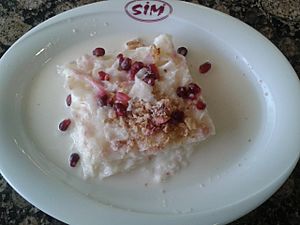Güllaç facts for kids
 |
|
| Course | Dessert |
|---|---|
| Place of origin | |
| Main ingredients | corn starch, wheat flour, walnuts, milk, pomegranate |
Güllaç is a yummy Turkish dessert. It's made with milk, pomegranate, and thin layers of pastry. People often enjoy Güllaç during the special month of Ramadan.
What is Güllaç?
Many people think Güllaç might be the ancestor of baklava. Both desserts use thin layers of dough. They also have nuts tucked between these layers.
Today, Güllaç dough is made from corn starch and wheat flour. But long ago, it was only made with wheat starch. Inside Güllaç, you'll find walnuts between the pastry sheets. These sheets are then soaked in milk.
A Look Back in Time
The first time Güllaç was mentioned was in the 14th century. It appeared in a book called Yinshan Zhenyao. This book was about food and health.
A doctor named Hu Sihui wrote it for the Mongol court. The book mainly described dishes from Mongol and Turkic cultures.
Güllaç was also used to make other old Turkish desserts. These were called Güllaç Lokması and Güllaç Baklavası. They were popular during the Ottoman period in Turkey.
Where Does the Name Come From?
The name "güllaç" comes from the Persian word gulanc. We first saw this word in a Turkic language in 1477. It was in a dictionary that translated Persian to Turkish.
See also
 In Spanish: Güllaç para niños
In Spanish: Güllaç para niños

